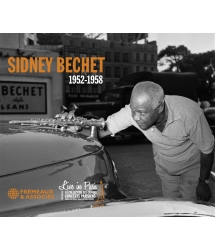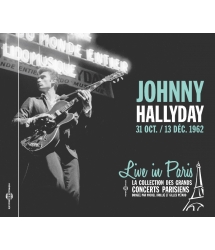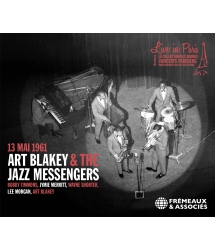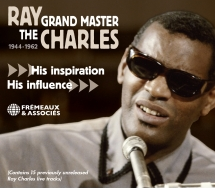- Our Catalog
- Philosophy
- Philosophers of the 20th century and today
- History of Philosophy (PUF)
- Counter-History and Brief Encyclopedia by Michel Onfray
- The philosophical work explained by Luc Ferry
- Ancient thought
- Thinkers of yesterday as seen by the philosophers of today
- Historical philosophical texts interpreted by great actors
- History
- Books (in French)
- Social science
- Historical words
- Audiobooks & Literature
- Our Catalog
- Jazz
- Blues
- Rock - Country - Cajun
- French song
- World music
- Africa
- France
- Québec / Canada
- Hawaï
- West Indies
- Caribbean
- Cuba & Afro-cubain
- Mexico
- South America
- Tango
- Brazil
- Tzigane / Gypsy
- Fado / Portugal
- Flamenco / Spain
- Yiddish / Israel
- China
- Tibet / Nepal
- Asia
- Indian Ocean / Madagascar
- Japan
- Indonesia
- Oceania
- India
- Bangladesh
- USSR / Communist songs
- World music / Miscellaneous
- Classical music
- Composers - Movie Soundtracks
- Sounds of nature
- Our Catalog
- Youth
- Philosophy
- News
- How to order ?
- Receive the catalog
- Manifesto
- Dictionnary
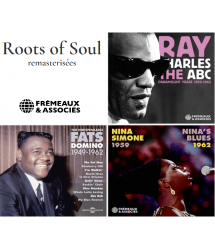
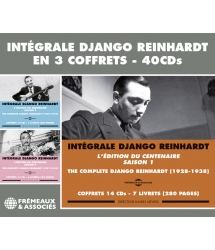
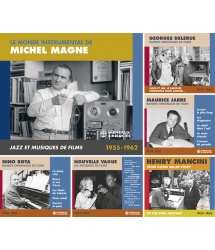
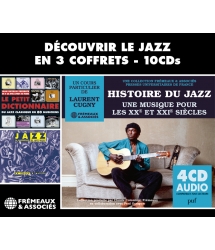







- Our Catalog
- Philosophy
- Philosophers of the 20th century and today
- History of Philosophy (PUF)
- Counter-History and Brief Encyclopedia by Michel Onfray
- The philosophical work explained by Luc Ferry
- Ancient thought
- Thinkers of yesterday as seen by the philosophers of today
- Historical philosophical texts interpreted by great actors
- History
- Books (in French)
- Social science
- Historical words
- Audiobooks & Literature
- Our Catalog
- Jazz
- Blues
- Rock - Country - Cajun
- French song
- World music
- Africa
- France
- Québec / Canada
- Hawaï
- West Indies
- Caribbean
- Cuba & Afro-cubain
- Mexico
- South America
- Tango
- Brazil
- Tzigane / Gypsy
- Fado / Portugal
- Flamenco / Spain
- Yiddish / Israel
- China
- Tibet / Nepal
- Asia
- Indian Ocean / Madagascar
- Japan
- Indonesia
- Oceania
- India
- Bangladesh
- USSR / Communist songs
- World music / Miscellaneous
- Classical music
- Composers - Movie Soundtracks
- Sounds of nature
- Our Catalog
- Youth
- Philosophy
- News
- How to order ?
- Receive the catalog
- Manifesto
- Dictionnary
1956-1961
Lionel Hampton
Ref.: FA5911
EAN : 3561302591124
Artistic Direction : Gilles Pétard et Michel Brillié
Label : FREMEAUX & ASSOCIES
Total duration of the pack : 2 hours 14 minutes
Nbre. CD : 2
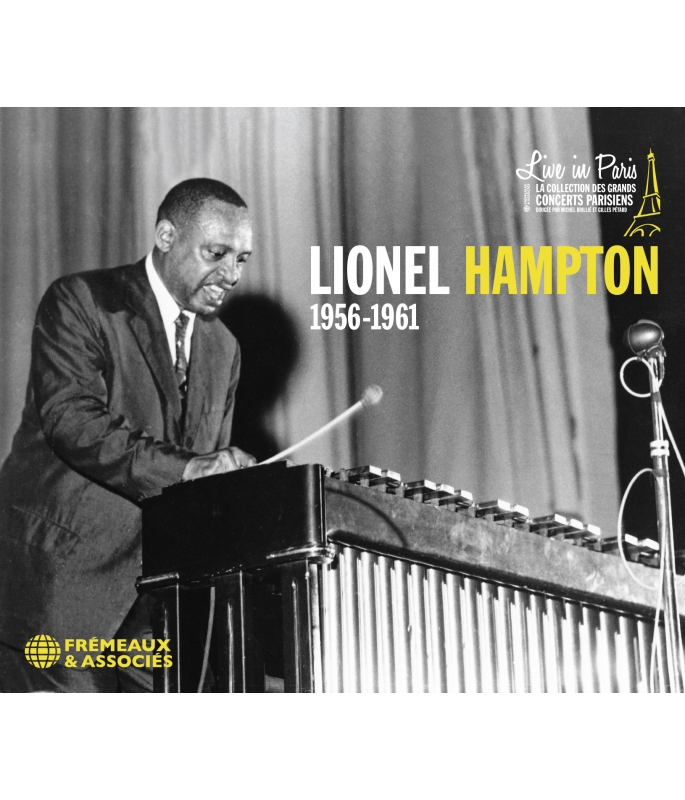
1956-1961
This live album brings together two legendary Parisian concerts, recorded in 1956 and 1961, that capture all the explosive energy and contagious enthusiasm of a «Lion» at the peak of his glory. These dynamite performances are a testament to the boundless generosity of one of the most formidable entertainers in jazz history, an artist capable of transforming a simple concert into a true show. The listener is carried away by Hampton’s infectious enthusiasm and the powerful swing of his big band. It’s dance jazz at its zenith.
Patrick FRÉMEAUX
The Live in Paris collection by Michel Brillié allows listeners to hear previously-unreleased recordings (made at concerts and private- or radio-sessions) by the great 20th stars in jazz, rock & roll and song. These “live” takes, and the artists’ rapport with their audiences, gives these performances an additional soul and sensibility in counterpoint to the rigorous demands of studio recordings. Particular care was taken when restoring the sound of these tapes in order to meet CD standards while preserving the original colours of the period.
Patrick FRÉMEAUX & Gilles PÉTARD
CD1 : ALBUQUERQUE SPECIAL • PAULETTE’S BOOGIE • PANAMA • GLADYS • FLYING AT THE OLYMPIA • MEMORIES OF YOU • HALLELUJA • BATTLE OF SAXES • BLUES FOR SACHA • ONE O’CLOCK JUMP • PATRICIA’S BOOGIE • PERDIDO • DRUMS FIGHT • ROCKING AT THE OLYMPIA • BLUES ONE • CLOPIN, CLOPANT.
CD2 : 10 RUE CAUMARTIN • HEY-BA-BA-RE-BOP • THE BIRTH OF THE BLUES • UNTITLED • MIDNIGHT SUN • TENDERLY • ALEXANDER’S RAGTIME BAND • ROLL’ EM PETE • FLYING HOME • HEY-BA-BA-RE-BOP • ON THE SUNNY SIDE OF THE STREET • HAMP’S BOOGIE WOOGIE • SPLANKY (NEAL HEFTI) • WHEN THE SAINTS.
DIRECTION ARTISTIQUE : GILLES PÉTARD ET MICHEL BRILLIÉ
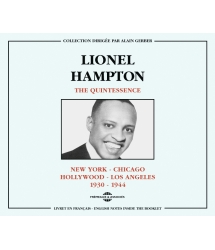
NEW YORK - CHICAGO - HOLLYWOOD - LOS ANGELES 1930 -...
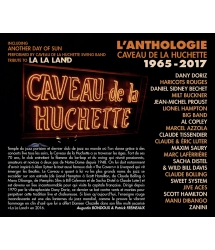
DANY DORIZ • HARICOTS ROUGES • DANIEL SIDNEY BECHET •...
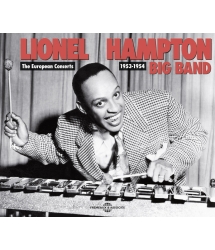
THE EUROPEAN CONCERT 1953 - 1954
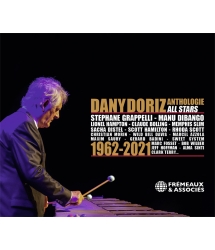
DANY DORIZ (FEATURING : STEPHANE GRAPPELLI • MANU...




-
PisteTitleMain artistAutorDurationRegistered in
-
1Albuquerque SpecialLionel HamptonLionel Hampton00:07:521956
-
2Paulette’s BoogieLionel HamptonLionel Hampton00:04:501956
-
3PanamaLionel HamptonCarl Sigman00:02:481956
-
4GladysLionel HamptonLionel Hampton00:05:471956
-
5Flying at The OlympiaLionel HamptonLionel Hampton00:06:141956
-
6Memories of YouLionel HamptonEubie Blake00:04:131956
-
7HallelujaLionel HamptonLionel Hampton00:04:061956
-
8Battle of SaxesLionel HamptonLionel Hampton00:04:171956
-
9Blues for SachaLionel HamptonLionel Hampton00:04:311956
-
10One O’Clock JumpLionel HamptonCount Basie00:02:341956
-
11Patricia’s BoogieLionel HamptonLionel Hampton00:05:231956
-
12PerdidoLionel HamptonJuan Tizol00:02:481956
-
13Drums FightLionel HamptonLionel Hampton00:03:301956
-
14Rocking at The OlympiaLionel HamptonLionel Hampton00:02:041956
-
15Blues OneLionel HamptonLionel Hampton00:01:531956
-
16Clopin, ClopantLionel HamptonPierre Dudan00:03:131956
-
PisteTitleMain artistAutorDurationRegistered in
-
110 Rue CaumartinLionel HamptonLionel Hampton00:10:011961
-
2Hey-Ba-Ba-Re-BopLionel HamptonLionel Hampton00:04:341961
-
3The Birth of the BluesLionel HamptonBuddy de Sylva00:02:541961
-
4UntitledLionel HamptonLionel Hampton00:05:061961
-
5Midnight SunLionel HamptonLionel Hampton00:05:131961
-
6TenderlyLionel HamptonJack Lawrence00:05:251961
-
7Alexander’s Ragtime BandLionel HamptonIrving Berlin00:03:231961
-
8Roll’ Em PeteLionel HamptonBig Joe Turner00:02:401961
-
9Flying HomeLionel HamptonSid Robin00:07:571961
-
10Hey-Ba-Ba-Re-BopLionel HamptonLionel Hampton00:03:401961
-
11On the Sunny Side of the StreetLionel HamptonDorothy Fields00:03:461961
-
12Hamp’s Boogie WoogieLionel HamptonLionel Hampton00:02:001961
-
13SplankyLionel HamptonNeal Hefti00:02:521961
-
14When the SaintsLionel HamptonTraditionnel00:08:281961
DOWNLOAD THE BOOKLET
Lionel Hampton Live in Paris 1956-1961
By Michel Brillié
King Hamp, The Swing Lion
God’s Drummer
All in all, Lionel Hampton wasn’t really self-centered. He twice paid tribute to the major personalities in his life who made his fame:
“Whatever success I’ve had in my life is due to my Mama Louvenia”[25] he writes at the very beginning of his auto-biography, Hamp.
A few pages later, he pays homage to the other big feminine influence in his life:
“God gave me the talent. Gladys gave me the inspiration.”[26]
Mama. Gladys. God.
Let’s start at the top. Mama Louvenia. This is his grand-mother, the undisputed head of the Hampton family. She was the one who made all the decisions, who did what, who attended which school, who registered which correspondence course.
Also Mama Louvenia was a true believer. Young Lionel would go along with her to the six o’clock prayer service, nine o’clock prayer service, service at eleven o’clock. The old lady from Setma, Alabama, would dedicate herself entirely to the Catholic faith.
As a full-time member of the Holiness Church in Birmingham, Alabama, Hampton would impatiently await Sunday’s service. The church would then really rock, with a big band with all kinds of instruments.
“My favorite instrument was the big bass drum” recalls Hamp[27]. “The sister who played it would beat that drum for hours, and then, suddenly the spirit would grab her. In my imagination, her soul left her body and was on its way up to God. Seemed to me that drumming was the best way to get close to God.”
Under Mama’s iron fist, the boy followed a most pious path. Every day, she would read to Lionel from the Bible; she decided to send him to a Catholic school run by Dominican sisters in Collins, Wisconsin. At one point the craziest showman of swing became an altar boy. He served with another boy, and when ringing the bell, tried to put “a little soul” into it.
Lionel’s Bible is at all times within reach. This really struck Jean Paul Vignola, a Frenchman who became his road manager for almost two decades. “He would read from the Bible at any time; once we played in Pau,in the South of France, and he insisted to make a detour to Lourdes, a famed place of pilgrimage. When we got there he bought a full gallon of holy water.”
“I’ve always been very religious. I carry my Bible with me, and I read a bit every day, so it meant a lot to me to be able to visit some of the places that are in the Bible.”[28]
While touring Israel, Hampton went to King David’s tomb, which inspired him to compose King David Suite, a classical piece of music. It was performed a number of times – by the symphony orchestras of Boston, Cincinnati, Toronto, San Diego…
But if Mama Louvenia gave him a good and strict education, if she was the angelic contribution to the upbringing of Lionel Hampton, could it be Gladys who misled him?
Gladys at the helm
“She was a beautiful girl – tall, light complected, carried herself well. She was part Indian, and older than I was by about three years. She was a lot more sure of herself. She was a career woman – worked for the movie studios as a seamstress. Later, I realized that Gladys was a lot like my grandmother.”[29]
Gladys and Lionel met in 1929, and, from that day until she died, she made all the major decisions. Lionel had come across a forceful woman. Or maybe it was the other way around : she had set her sights on him. Great. So he would play the young fool’s part, focus on his music while she would take care of business.
And there we have multiple examples of her good and strict management. Here’s a rather comic one: as a seamstress, Gladys made the silk drawers of famous movie stars. They would wear them only three four times. Whenever they got rid of their silk underwear, she’d take them back home to Lionel. So Hamp slipped into Douglas Fairbanks’, or Clark Gable’s shorts…
Then she was really fearsome in her management of the band. Anyone who knew Hampton
called him a cheapskate; but it was far from her way of running the business.
As a trumpet player at the beginning of his career, Quincy Jones played in Lionel Hampton’s band. “Gladys made a ton of money for him,”[30] writes Q in his book. When he was asked to join the band for the 1953 European tour, he got nervous. “I knew how Hamp worked back in the States. If you were in a town and a horn player sat in with the band and played better than you, Hamp would fire you, hire that guy, then pay your car fare home out of that guy’s seventeen-dollars –a-night salary.”[31]
Gladys was his CFO, press officer, she was ubiquous. She had no problem confronting the big guys: Joe Glaser, Louis Armstrong’s artist manager; Norman Granz, the concert promoter; or Felix Marouani, the impresario. Hamp credits her for pushing him to switch from drums to vibraphone, convinced that this instrument would make him famous. Gladys gave Lionel a vibraphone for his birthday, right from the Cotton Club days in Les Hite’s line-up.
A wonderful pair. On one hand, Lionel’s amazing musical talent, on the other the cunning business acumen of Gladys. Together they established their own record label, Glad-Hamp, as well as their own music publishing company, Swing and Tempo. Gladys and Lionel also were very involved in helping their own community. One of their projects was the building of the the low-income housing units, the Lionel Hampton Houses. After Gladys died in 1971, Lionel opened more low-income housing units in New York, named the Gladys Hampton Houses. On the cornerstone, Lionel had inscribed, “God gave me talent, but Gladys gave me the inspiration.”
Gladys would even stick her nose in the organization of the band. In 1954, she vetoed Hampton’s offer to Julian Adderley to join the band because his older brother Nat was already a part of it, and she believed that two brothers in the orchestra would result in the formation of cliques.[32] Conversely, when Hamp hired young Betty Carter to sing with his band, “He’d look at me and ask dumb questions like “whose band do you like best, mine or Dizzy’s? I’d say Dizzy’s, and he would fire me, and Gladys Hampton would rehire me.”[33]
Famous music producer John Hammond also thought she was the real boss of the band. So does Hampton: “It was Gladys who thought about the future. I know that a lot of the guys didn’t understand how I could let a woman be in the lead, but today I’m a lot better off than many of them, because of Gladys.”[34]
Showtime
Where Hamp was the sole decision-maker was for everything that put on a show. Sax-flute player Jerome Richardson joined the band as early as 1951: “Hamp’s single purpose was to entertain, and if you where in that band that’s what you had to do.”[35]
Hampton had a habit of stealing the best bits of showmanship that his sidemen invented. At a tightly packed concert, an alto sax started “walking the rail” while playing, and fell backwards into the crowd. The people put their hands up and caught him, pushing him back onto the stage. At a later date, Hampton grabbed a saxophone and jumped up on the footlight rail. He honked a wild riff, then turned his back and fell backwards into the crowd too. This time the turnout wasn’t as heavy, and people had room to step out of the way. Hamp fell flat on his back on the floor. The band laughed so hard they could barely continue playing.[36]
Hampton would go out of his way to have his guys put on a show. One day the band played a concert in Washington on a barge on the banks of the Potomac River. Sax player Illinois Jacquet had played before and got the crowd in the palm of his hand. Then Hampton came with his band and didn’t get much of a reaction. So while the band continued, he went back to Monk Montgomery, who was playing Fender bass and told him, “Gates, you jump in the river on the next chorus, I’ll give you an extra ten.”
When the band got to the next crescendo and Ham raised his mallets, Monk jumped over the railing. The audience went crazy. The band kept playing and a few minutes later Monk came out on stage soaking wet. Hamp walked over to him and said, “Another ten if you do it again.” [37]
Those wild antics, contortions and ongoing riffs, all the music that Hampton performed was already pure Rock and Roll. Jerry Lieber and Mike Stoller, two of the greatest producers of American black music of the fifties and sixties, summed up this incredible uniqueness: “ Hamp had a swing band, a bop band and, at the same time, a rocking, rolling R&B band.”[38]
As far as Hampton was concerned, it was the same thing,” it’s always jazz. You can put a new dress on her, a new hat, but no matter what kind of clothes she’s the same old broad.”[39]
Speaking of clothes, you had to be thick-skinned to endure the man’s whims. Quincy Jones recalls that shameful feeling he had onetime in New-York: “ When we played the Band Box next door to Birdland, Hamp made the band dress up in purple jackets, Bermuda shorts, and Tyrolean hats and play like bandoliers. We’d march up the steps to the street behind Hamp, who beat his drumsticks on any available surface. Hamp didn’t give a hoot about looking cool. He was a showman and he’d do anything to bring people into clubs to catch his band.”[40]
The online site jazzwax.com shows several videos of crazy live performances:
Musicians throw their instruments at each other while a trumpeter soloes, clapping their hands all the while…Suddenly a sax man jumps over the frontline of trombones to begin his chorus…He dances and contorts himself like a maniac. For the finale, Hampton returns to the front of the stage to end the song by juggling his drumsticks. At times he juggles with five of them, tucking one under his arm, or his chin…Now it’s time for the drum fight. A rolling drum kit is wheeled onto Hamp, with two sets of snares and toms next to the bass drum… Hamp and partner Joe Adams try to outperform each other, when appear from all sides dancers young and old, even a grand-ma…[41]
The Ambassador of Jazz
As early as 1953, the Hampton took an interest to Europe. On a practical level, there they were free from any legal problems, unlike their complicated situation in the USA. Jazz was trendy on the Old Continent, so this ’53 European tour was a great success. It ran through fifteen weeks and eighty- seven concerts. The band, with a new addition, young trumpeter Quincy Jones, stopped in Scandinavia, Germany, Holland, Switzerland and France. In Paris, in between his Palais de Chaillot dates, Hampton took advantage of it to join several recording sessions, with Gigi Gryce, Art Farmer, or Clifford Brown. This is something that he would do on almost every trip to France. Gladys, for her part, had Christian Dior design a whole wardrobe for her as a publicity stunt.
On that trip the couple also had the opportunity to meet Josephine Baker, who became a close friend of Gladys. The dancer later wrote in a letter “how proud I am dear because (Lionel’s success) is what will give our people confidence in themselves.”[42]
The showman was back again in ’54. French writer and jazz fan Boris Vian summed it up in his December ’54 Arts Magazine review: “oh, it’s not always intellectual and sophisticated jazz, but it’s alive, it’s a hot and swinging jazz show!”
And on to January 1956. Gladys Hampton had minutely organized this new tour for her favorite artist: over 300 concerts in thirteen countries for a period of seven months, their longest tour yet. The gang sailed for Europe on the USS United States and arrived at Le Havre on January 16. Hampton, who was injured with a broken ankle three months before, had no problem doing his usual antics on stage, jumping around all over the place. After playing in Versailles, they set up camp for three weeks at the Olympia Theater in Paris. Stage manager Jean Michel Boris recalled vividly that time:
From January 19 to February 7, it was a series of blazing performances by Lionel Hampton and his orchestra. It marked the great comeback of the vibraphonist that the audience of the Olympia discovered a little more than a year ago. Lionel is a relentless entertainer, as famous in France as Gilbert Bécaud. He was surrounded by an array of over-excited girls. Lionel and his big band put out a breathtaking show for a stand-up crowd dancing the be-bop, almost in a trance.[43]
The newspaper Le Monde was also impressed:
Lionel Hampton now knows the way to the Olympia. With his instrument, he monopolizes the stage without further ado. As soon as the mallets strike the metal rods of the vibraphone, the spell is cast, and the musicians behave like little children, thrilled and ready to blissfully faint. The audience also blossoms at the bewitching secrets of music.
And thus everything becomes possible. This circus thrives for an entire hour, beating like a huge heart. To keep it alive you just have to seep from time to time these tiny cells of rhythm called riffs. These unfailing fibers of energy are all similar: bass notes of a boogie, trios of notes. These old recipes are tireless.[44]
It was always showtime with that guy Hamp. The very day he opened at the Olympia, he also jammed along with fellow musicians Sidney Bechet and Claude Luter at the Vieux Colombier Club in St Germain des Prés. Back in Paris in May, he sat in at various recording sessions with French jazzmen Claude Bolling and Guy Lafitte. Here he was in June a guest star for a live broadcast of Pour Ceux Qui Aiment le Jazz in the Tuileries Gardens, with Claude Luter’s Lorientais Band or Henri Renaud, Bill Coleman, René Urtreger…
1960 marked the end of an era. Times were tougher for big bands. Hampton turned to overseas touring, in South America or Europe. This was also the time when he spoke out his stand on American politics during this presidential election year, by appearing at public meetings for…Nixon. Hampton asserted that he always was a Republican because “it was Abraham Lincoln’s party.” Over time, he became a personal friend of Dwight Eisenhower , and then Nixon, “ He and I went way back. Whenever Nixon called, I’d drop whatever I was doing to play for his campaign.”[45] In 1996, he was disappointed with the Republican program and backed Bill Clinton.
And on went the extensive succession of tours…On March 25, 1961, it was once more in Paris at the Olympia Theater. For that occasion, Hampton didn’t choose to pay homage to the Coquatrix family, the owner of the house. No “Patricia” or “Paulette’s Boogie” (the daughter and wife of Coquatrix) nor “10 rue Caumartin” (its backstage entrance). It was a more traditional set list: “Flying Home”,”Hey BaBaReBop”, “When the Saints”… a golden selection.
The daily newspaper Le Figaro had earlier well described that amazing mood:
The trumpets swing like palms in the wind. The saxes sway like drenched pitchers. Hampton claps his hands and sticks his tongue out. Large drops of sweat fall from his face onto his vibraphone, solidly still in tune.[46]
Cassoulet Blues
The Ambassador of Jazz returned frequently to France in the following years. In the last two decades of the twentieth century, his band appeared at all the major festivals, Juan les Pins, Marciac, la Grande Parade du Jazz in Nice. It was also in 1983 in this Riviera town that Hampton sat in to record a tribute to Georges Brassens’ repertoire. At his side were top artists Henri Salvador, Clark Terry, and Moustache, who initiated the album. For his part, Hampton was the recipient of many tributes to his talent: the Medal of the City of Paris, from the hands of Jacques Chirac in ’84; Culture Minister Philippe Léotard granted him the award of Commandeur des Arts et Lettres in ’88. “He liked being honored, he was a bit of a ham,” recalls his old partner Jean-Pierre Vignola.
On another note, Lionel was made a knight of the…wines of the Côtes-du-Rhône region, and also of one of his favorite French speciality, the Cassoulet (a stew of sausage, confit of duck and white beans). Vignola confessed on one occasion he turned out late for a concert in Carcassonne, the French city famous for its cassoulet. To be forgiven, he improvised on stage “The Cassoulet Blues”. France’s “Brotherhood of Cassoulet” officials then traveled to Paris to give him the award.
In April ’99, as Hampton was just about to turn ninety-one- years-old, he came back “home” once more to play at the Jazz Club Lionel Hampton in the Méridien Hotel in Paris. The idea of naming that place after the vibraphonist had jointly stemmed from Vignola and Moustache, the iconic drummer from the Saint-Germain-des-Prés era. The club became a sought-after music spot for several decades. B.B. King, Fats Domino, Ike Turner, Solomon Burke, Cab Calloway performed there at one time or another in front of enthusiastic crowds.
During an entire week, the Jazz Club was packed with fans here to see, probably for the last time, the incredible artist. Claude Bolling, Sacha Distel, Manu Dibango, Nicole Croisille, Eddy Barclay, George Wilson, and many Hamp followers payed homage to this historical figure of jazz, as he was celebrating his ninety-first birthday and his seventy-five years on stage. For the occasion, the Méridien Hotel had especially created the “Cuvée Lionel Hampton” champagne.
He was unfortunately in a disabled condition. He had gone through three major heart attacks, one of them in ’92 as he was appearing at a Paris venue. He moved only in a wheelchair; on stage, he could play his instrument with one sole hand. But his band was just full swing ahead. He answered with a smile to the New York Times interviewer,
“I love music so much. And I thank the Lord that I still play it.”[47]
After his death in August 2002, jazz writer and producer Frank Ténot wrote in his Jazz Magazine column, “When he played, it was as if the ocean was improvising.”[48]
Michel Brillié
© Frémeaux & Associés 2025
Lionel Hampton Live in Paris 1956-1961
CD1
1 Albuquerque Special (Al Hayse / Lionel Hampton) 07’52
2 Paulette’s Boogie (Lionel Hampton) 04’50
3 Panama (Carl Sigman - William Henry Tyers) 02’48
4 Gladys (Lionel Hampton) 05’47
5 Flying at The Olympia (Lionel Hampton) 06’14
6 Memories of You (Eubie Blake) 04’13
7 Halleluja (Lionel Hampton) 04’06
8 Battle of Saxes (Lionel Hampton) 04’17
9 Blues for Sacha (Lionel Hampton) 04’31
10 One O’Clock Jump (Count Basie) 02’34
11 Patricia’s Boogie (Lionel Hampton) 05’23
12 Perdido (Juan Tizol) 02’48
13 Drums Fight (Lionel Hampton) 03’30
14 Rocking at The Olympia (Lionel Hampton) 02’04
15 Blues One (Lionel Hampton) 01’53
16 Clopin, Clopant (Pierre Dudan / Bruno Coquatrix) 03’13
Total Time 1:06’03’’
Recording Date
28 and 30 January, 1956
Recording Place
Olympia Theater, Paris, France
Produced by
Bruno Coquatrix & Norman Granz
Personnel
Alto Saxophone, Flute: Bobby Plater
Baritone Saxophone: Curtis Love
Bass: Peter Badie
Clarinet, Alto Saxophone: Scoville Brown
Drums: Albert “June” Gardner
Guitar: Billy Mackel
Piano: Oscar Dennard
Tenor Saxophone: Ricky Brauer
Trombone: Al Hayse, Larry Wilson,
Walter “Phatz” Morris
Trumpet: Billy Brooks, Dave Gonsalves,
Ed Mullens, Ed Preston
Vibraphone, Percussion, Drums, Vocals:
Lionel Hampton
CD2
1 10 Rue Caumartin (Lionel Hampton) 10’01
2 Hey-Ba-Ba-Re-Bop (Milt Buckner / Lionel Hampton) 04’:34
3 The Birth of the Blues (Buddy de Sylva / Lew Brown Ray Henderson) 02’54
4 Untitled (Lionel Hampton) 05’06
5 Midnight Sun (Johnny Mercer Sonny Burke / Lionel Hampton) 05’13
6 Tenderly (Jack Lawrence / Walter Gross) 05’25
7 Alexander’s Ragtime Band (Irving Berlin) 03’23
8 Roll’ Em Pete (Big Joe Turner / Pete Johnson) 02’40
9 Flying Home (Sid Robin - Benny Goodman / Eddie de Lange) 07’57
10 Hey-Ba-Ba-Re-Bop (Milt Buckner / Lionel Hampton) 03’40
11 On the Sunny Side of the Street (Dorothy Fields / Jimmy McHugh) 03’46
12 Hamp’s Boogie Woogie (Lionel Hampton / Milt Buckner) 02’00
13 Splanky (Neal Hefti) 02’52
14 When the Saints (Traditional) 08’28
Total Time 1:07’59’’
Recording Date
Mar. 25th, 1961
Recording Place
Olympia Theater, Paris, France
Produced by
Norman Granz, Frank Ténot & Daniel Filipacchi
Personnel
Alto Sax, Clarinet, Flute: Bobby Plater
Alto Sax, Clarinet: John Neely
Barytone Sax, Flute: Lonnie Shaw
Bass: Lawrence Burgan
Drums: Wayne Robinson
Guitar: Roland Faulkner
Piano: Harold Mayburn
Tenor Sax, Clarinet, Flute: Edward T. Parant
Tenor Sax, Clarinet: Andrew Mc Ghee
Trombones: Vincente Prudente, Harlan Rasheed
Trumpets Dave Gonzales, Floyd Jones,
Andrew Wood, Virgil Jones
Vibraphone, Drums: Lionel Hampton
Vocals: Beatrice Reading, Pinocchio James
and Lionel Hampton
Dedicated to Claude Boquet, Bill Dubois, Jean Claude, Philippe Moch, Raymond Treillet and the gang.
La collection Live in Paris :
Collection créée par Gilles Pétard pour Body & Soul et licenciée à Frémeaux & Associés.
Direction artistique et discographie : Michel Brillié, Gilles Pétard.
Coordination : Augustin Bondoux / Conception : Patrick Frémeaux, Claude Colombini.
Fabrication et distribution : Frémeaux & Associés.[1]
[1]. Lionel Hampton, Hamp, Warner Books, 1989, p6
[2]. Lionel Hampton, op. cit. en dédicace de l’œuvre
[3]. Lionel Hampton, op. cit. p8
[4]. Lionel Hampton, op. cit. p119
[5]. Lionel Hampton, op. cit. p 33
[6]. Quincy Jones, Q , Doubleday, 2001 ,p 81
[7]. Quincy Jones, op.cit.p 86
[8]. Cary Ginell, Walk Tall, Hal Leonard Books, 2013, p8
[9]. Bill Crow, Jazz Anecdotes, Oxford University Press, 1990, p59
[10]. Lionel Hampton, op. cit. p61
[11]. Quincy Jones, op.cit.,p 73
[12]. Bill Crow, op cit, p293
[13]. Bill Crow, op cit, p296/97
[14]. Jerry Lieber & Mike Stoller Hound Dog, Omnibus Press, 2009 p46
[15]. https://www.azquotes.com/author/21146-Lionel_Hampton
[16]. Quincy Jones, op.cit.,p 83
[17]. https://www.jazzwax.com/2019/08/10-lionel-hampton-videos.html
[18]. Lionel Hampton, op. cit. p101
[19]. J.M. Boris, J.F. Brieu, E. Didi, Olympia Bruno Coquatrix, Editions Hors Collection 2003 ,p 25
[20]. Philidor, Le Monde, 23 janvier 1956
[21]. Lionel Hampton, op. cit. p132
[22]. Le Figaro, Janvier 1956
[23]. Mike Zwerin, Packing the House at 91 : Lionel Hampton Is Still Swinging , New York Times, 7 avril 1999
[24]. Frank Ténot, Frankly Speaking, Editions du Layeur, 2004 p283Frank Ténot, Frankly Speaking, Editions du Layeur, 2004 p283
[25]. Lionel Hampton, Hamp, Warner Books, 1989, p6
[26]. Lionel Hampton, op. cit. Book dedication
[27]. Lionel Hampton, op. cit. p8
[28]. Lionel Hampton, op. cit. p119
[29]. Lionel Hampton, op. cit. p 33
[30]. Quincy Jones, Q , Doubleday, 2001 ,p 81
[31]. Quincy Jones, op.cit. p 86
[32]. Cary Ginell, Walk Tall, Hal Leonard Books, 2013, p8
[33]. Bill Crow, Jazz Anecdotes, Oxford University Press, 1990, p59
[34]. Lionel Hampton, op. cit. p61
[35]. Quincy Jones, op.cit., p 73
[36]. Bill Crow, op cit, p293
[37]. Bill Crow, op cit, p296/97
[38]. Jerry Lieber & Mike Stoller, Hound Dog, Omnibus Press, 2009 , p46
[39]. https://www.azquotes.com/author/21146-Lionel_Hampton
[40]. Quincy Jones, op.cit.,p 83
[41]. https://www.jazzwax.com/2019/08/10-lionel-hampton-videos.html
[42]. Lionel Hampton, op. cit. p10
[43]. J.M. Boris, J.F. Brieu, E. Didi, Olympia Bruno Coquatrix, Editions Hors Collection 2003 , p 25
[44]. Philidor, Le Monde, 23 janvier 1956
[45]. Lionel Hampton, op. cit. p132
[46]. Le Figaro, Janvier 1956
[47]. Mike Zwerin , Packing the House at 91 : Lionel Hampton Is Still Swinging , New York Times, April 7 , 1999
[48]. Frank Ténot, Frankly Speaking, Editions du Layeur, 2004 p283

